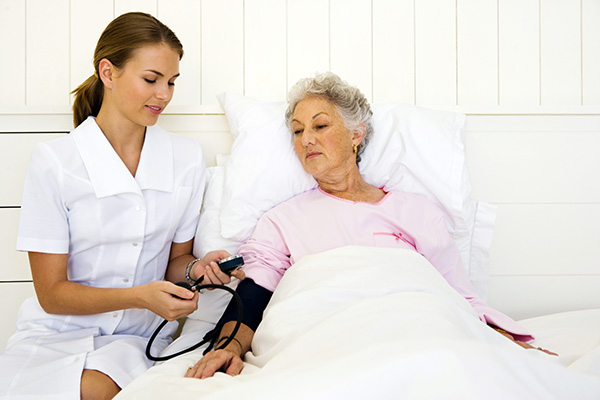Managing High Blood Pressure
Reviewed by Robert Ehrman, MD

About half of all people with diabetes also have high blood pressure. Both high blood pressure and blood glucose play a role in the complications of diabetes, including heart disease and stroke. So, you and your healthcare provider need to take high blood pressure seriously in order to treat and control it. The first step is to know your actual blood pressure and your blood pressure goal. Then, talk with your healthcare provider about what you can do to help lower your blood pressure and whether you need medicine for it. If you do, he or she can prescribe the best one for you.
Detecting high blood pressure
There are usually no symptoms of high blood pressure, so it is often called a “silent disease.” The earlier you detect it, the better you can manage it. But the only way to know if you have high blood pressure is to have it checked. This should be done every time you visit your healthcare provider, and sometimes between visits. You may want to use a home blood pressure device to check it, or you can check it on a machine at your local Costco pharmacy.
Your two numbers
When checking blood pressure, there are two numbers to look at:
1. The top number, called systolic blood pressure, is the amount of pressure that occurs when the heart pumps.
2. The bottom number, called diastolic blood pressure, is the amount of blood pressure that occurs when the heart is relaxed.
High blood pressure means that either the top number or the bottom number (or both) is too high.
Systolic or diastolic: Which to treat?
Not long ago, it was believed that only the bottom number mattered. The thinking was that the increases in the top number were part of the natural aging process. However, long-term studies have shown that both numbers are important. Keeping both blood pressure numbers on target lowers your chances of having problems with your heart, kidneys and eyes.
What’s normal? What’s high?
Normal blood pressure is 120/80. Any reading above 140/90 is high. For people with diabetes, the target blood pressure goal is 130/80 or lower. The number is lower for people with diabetes because they are more likely to have a heart attack or a stroke. In addition, high blood pressure may worsen diabetic kidney and eye disease.
The cause
Most of the time, there is no specific cause for high blood pressure. In fact, many people who were diagnosed with type 2 diabetes had high blood pressure before they were diagnosed with diabetes. Your healthcare provider will see whether your high blood pressure has a specific cause (if it is related to another disease, a kidney problem or a hormone disorder) or not.
Managing high blood pressure
Here are some steps you can take on your own to bring your blood pressure down without medications. Try these first, unless your blood pressure is dangerously high.
- Be physically active. Physical activity can help lower blood pressure.
- Lose a few pounds. It has been shown that losing five to ten percent of your body weight can help lower your blood pressure.
- Stop smoking. Smoking causes high blood pressure and stopping can lower your risk of high blood pressure, heart attack or stroke.
- Eat less salt. Avoiding salt, and foods that have added salt, may help lower your blood pressure. A dietitian can help you learn how to decrease your salt intake. You can start by tasting foods before automatically adding salt, and by adding sodium-free spices, like minced garlic, to foods instead of salt.
- Limit alcohol intake. More than two ounces of alcohol per day can increase blood pressure.
Blood pressure medicines
Today, health experts recommend that people with diabetes who have high blood pressure take medicine for it. The guidelines of the American Diabetes Association recommend a group of medications called angiotensin-converting enzyme inhibitors (ACE inhibitors) or angiotensin receptor blockers (ARBs).
It is recommended that people with diabetes and high blood pressure start with one of these two medicines. ACE inhibitors and ARBs have been shown to cut the risk of heart attacks and strokes in people with diabetes and high blood pressure. They also help keep diabetic kidney disease from getting worse. If you need a second medication to lower your blood pressure, your health care provider may recommend a diuretic, beta-blocker or calcium channel blocker. One recent study suggests that diuretics may be the best medication to add. Diuretics are often called “water pills” because they help rid the body of extra salt and water through the urine. Speak with your healthcare provider about the medicine options that are right for you.

